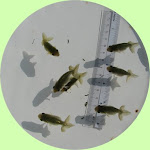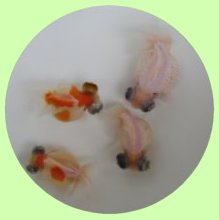~ 2% salt dip (20 grams of salt per litre) - used for short (a.k.a 'shock') dip to kill microscopic parasites like gill and body flukes.
~ 0.5% salt treatment (5 grams of salt per litre) - used for short term acclimatizing and treatment of goldfish during quarantine stage.
How to measure salt concentration (salinity):
By weight:
- using a kitchen scale, 0.5% salt is 5 grams/litre and 2% salt is 20 grams/litre.
By a Refractometer:
- an easy and accurate way to measure salinity is using the optical instrument known as the refractometer.
- sample 3 drops of water onto the optical surface and close the lead. Look through the eye piece against a light source to see the readings.
- Depending on the model of the refractometer. Use the ‰ (or per-mille) scale on the right hand side and refer to the following picture for readings on 0.5% and 2% salinity highlighted in red.
- Please note that 1‰ = 0.1% and read accompanying instructions of the refractometer for proper usage and calibration.
 |
| A Refractometer |
Salt as a treatment for parasites:
In goldfish, a very common parasite is the gill flukes (microscopic parasites) and most of them could be eradicated with a few cycles of 2% salt dip followed by 0.5% salt treatment.
Salt as a therapeutic agent:
The 0.5% salinity is a very important concentration use in therapeutic treatment because the blood salinity of many vertebrates are close to 0.5%. Incidentally, salt soothes the goldfish by improving gill functions and reducing osmotic pressure. It also aides in the healing of wounds and induces a healthy slime coating. In this concentration, besides calming the fishes, it is effective against the eggs and further propagation of many parasites. As salt is rather inert against most other commercial medications, it can be safely added to most anti-bacterial and anti-fungal medications. The best practice when using salt concurrently with another drug is to consult expert advises or documentation first (for example, it is widely believed that salt should never be used together with formalin or potassium permanganate, mainly due to the dyhyrating/oxidising properties of these drugs which deplete the already reduced dissolved oxygen in salt treated water).
 |
Salt is indispensable for the Ranchu
~ A local bred TVR 2013 |
Salt as an acclimatizer when mixing fishes:
When introducing new goldfish to your current collection, even if the new fishes are fully quarantined, extreme caution must be observed to acclimatize the 2 groups together. This is because goldfish from different tanks/ponds are hosts to their residential pathogens found in their habitats. Crossed contamination when they are mixed together triggered an onslaught of new pathogens that their body immune system may not be prepared to counter react. The story of how an introduction of new fishes managed to wiped out the whole community in days is all too familiar. In many cases, either the existing community or the new fishes survived, depending on which pathogen is "stronger".
Just like the common flu bug that is always present in healthy humans, healthy fishes would still be hosting some pathogens. These pathogens exist in equilibrium with the immune system of the host body. Paradoxically, it keeps the fishes healthy by having a busy and active immune system. However, an outbreak can be triggered when the host is excessively stressed or weakened due to external factors, like poor water quality or the introduction of new fishes.
The objective of a proper fish mixing regime aims to eradicate as much of these flukes and weaken their effects so that both communities of fishes can gradually acclimatize to each others' presence.
A salt dip demonstration
Salt dip procedure:
If the goldfish is reasonably big and that you are confident, gently ply open its gill plate a little to look at its gills. The gills should be blood red and that the gill filaments are full and healthy, not dull red, pink or whitish. Those with pink or dull coloured gills should be treated with anti-bacteria gill medications.
1) Change 80% to 90% of the water in the pond/tank and add in new dechlorinated water.
2) Use rock salt (please do not use the table salt) to dose the tank with 0.5% salinity (make sure all the salt are melted before taking the readings).
3) Prepare a small container of dechlorinated water with 2% salt solution. If the container is big, you may perform the salt dip for more fishes at the same time, otherwise, you can do it one at a time.
4) Dip all the new and current fishes in your collection that you wish to mix together in the small container of 2% salinity solution from 3 to 5 minutes. The fishes will struggle and may even float sideways and grasp for air. If you are new to this and not so confident yet, you may perform shorter dips in a few intervals.
 |
Routine salt bath also keeps older
fishes healthy, like this pair of 2.5 years old
Pearlscales |
5) Take out the fish and let them recuperate in a small bowl of clean dechlorinated water for 5 minutes and than transfer it back to their habitat pond/tank that was previously dosed with 0.5% salinity.
6) In this period, do very light feeding and monitor that all the fishes are active. If a water change is needed, re-dose the new water to 0.5% salinity.
7) Repeat steps 4) to 6) on the 4th day, 8th day and 12th day to rid of the adult and larvae flukes that hatch approximately every 3 to 4 days.
If you have lasted through to this part of the article, I am glad that my effort to share has paid off. As with the old adage that we should take things we hear with a pinch of salt, the best way is still to try it out yourself ;-))






















